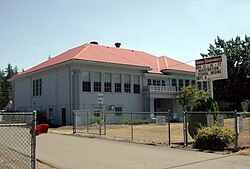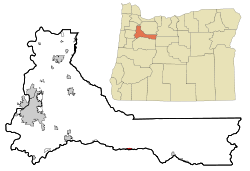2010 census
As of the census of 2010, there were 471 people, 222 households, and 129 families living in the city. The population density was 724.6 inhabitants per square mile (279.8/km2). There were 249 housing units at an average density of 383.1 per square mile (147.9/km2). The racial makeup of the city was 92.4% White, 0.2% African American, 1.7% Native American, 0.8% Asian, 0.4% from other races, and 4.5% from two or more races. Hispanic or Latino of any race were 4.5% of the population. [5]
There were 222 households, of which 22.1% had children under the age of 18 living with them, 44.6% were married couples living together, 5.9% had a female householder with no husband present, 7.7% had a male householder with no wife present, and 41.9% were non-families. 36.9% of all households were made up of individuals, and 12.7% had someone living alone who was 65 years of age or older. The average household size was 2.12 and the average family size was 2.70. [5]
The median age in the city was 47.9 years. 19.1% of residents were under the age of 18; 5.2% were between the ages of 18 and 24; 21.2% were from 25 to 44; 32.4% were from 45 to 64; and 21.9% were 65 years of age or older. The gender makeup of the city was 53.9% male and 46.1% female. [5]
2000 census
As of the census of 2000, there were 471 people, 208 households, and 136 families living in the city. The population density was 773.5 inhabitants per square mile (298.7/km2). There were 261 housing units at an average density of 428.7 per square mile (165.5/km2). The racial makeup of the city was 87.47% White, 2.97% Native American, 0.21% Asian, 4.03% from other races, and 5.31% from two or more races. Hispanic or Latino of any race were 6.37% of the population. [5]
There were 208 households, out of which 21.6% had children under the age of 18 living with them, 55.3% were married couples living together, 4.8% had a female householder with no husband present, and 34.6% were non-families. 29.3% of all households were made up of individuals, and 15.4% had someone living alone who was 65 years of age or older. The average household size was 2.26 and the average family size was 2.79. [5]
In the city, the population was spread out, with 20.2% under the age of 18, 5.7% from 18 to 24, 22.1% from 25 to 44, 31.2% from 45 to 64, and 20.8% who were 65 years of age or older. The median age was 47 years. For every 100 females, there were 104.8 males. For every 100 females age 18 and over, there were 102.2 males. [5]
The median income for a household in the city was $32,344, and the median income for a family was $37,143. Males had a median income of $35,714 versus $31,250 for females. The per capita income for the city was $17,065. About 15.9% of families and 17.9% of the population were below the poverty line, including 23.1% of those under age 18 and 11.0% of those age 65 or over. [5]



